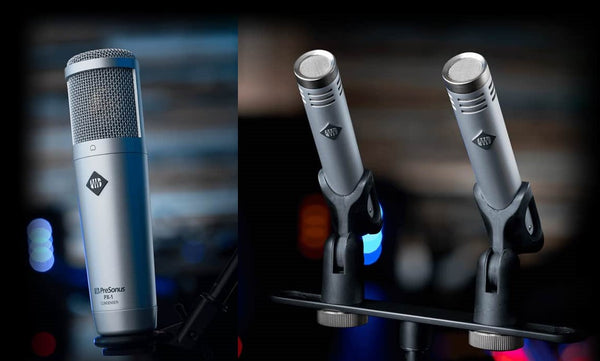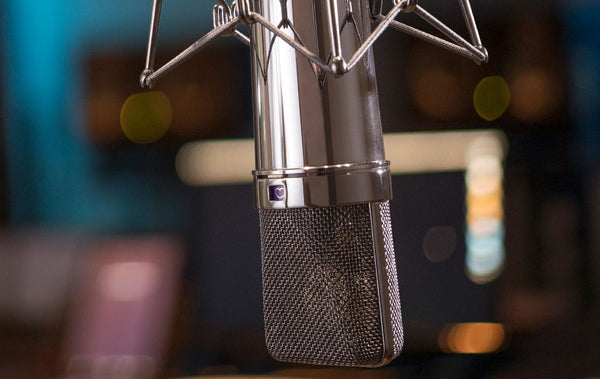For content creators having a great microphone makes all the difference in sound production. A condenser microphone is a high-quality microphone that will help you produce a clear and natural voice when recording. These microphones are an excellent choice for professional studio and home productions.
However, they are more suitable for studio productions or sound proof rooms because of their fidelity and high sensitivity. They also have a wide frequency response range compared to dynamic microphones but with a low input sensitivity.
This article will help you understand condenser microphones better by reviewing its characteristics, advantages and disadvantages.
What Is a Condenser Microphone, and Why Should You Be Using One?
A condenser microphone transforms sound energy into electrical energy using electrostatics. It is also known as a capacitor microphone. The mic has a sensitive sound pickup, making it suitable for audio recording.
Condenser microphones rely on a specific, sensitive vibrating diaphragm to capture sound. The mics are more sonically sensitive and fragile than other microphones, making them excellent for vocals, acoustic instruments, drum overheads, and voice recordings.
However, dynamic microphones are better when capturing loud sounds or using instruments such as bass amplifiers and guitars.

Characteristics of a Condenser Microphone
- Condenser microphones have low mass weight. This enables it to vibrate with sound waves of the input source more accurately, producing superior quality sounds than other microphones.
- Condenser microphones are versatile. They are also the most versatile microphones for recording studios, as they can capture clear sounds from most instruments.
- Polar patterns. You can find condenser microphones of cardioid, bidirectional, or omnidirectional polar patterns. A cardioid condenser microphone is sensitive to sounds from only one direction. On the other hand, a bidirectional condenser microphone is sensitive to sounds from two opposite directions. Lastly, an omnidirectional microphone is sensitive to sound from all directions.
- Condenser microphones have a thin, suspended diaphragm supported by a fixed frame. The diaphragm moves because of the pressure that sound waves exert against it.
- Condenser microphones require an external source of power. Condenser microphones use phantom power as a source of energy. Some use batteries as a source of power.
- The microphones produce clear, authentic sounds. When compared to dynamic mics, a condenser microphone makes more authentic sounds.
Types of Condenser Microphones
There are two types of condenser microphones; the large diaphragm and the small diaphragm condenser mic.
The large diaphragm condenser microphone
The large diaphragm picks low-end and deeper voices better. They are more suitable when you want a big and warm sound. It is no wonder they are more considered for recording vocals and voice-overs, and, when using some instruments, it will add richness to the sound by accentuating low frequency.
In addition, the mics are highly sensitive, and you can record and achieve excellent sound even with the hums of your AC.
The Small Diaphragm Condenser Microphone
The small diaphragm condenser microphone picks high-frequency sounds better. They are more ideal when you want to capture the natural sound without fine-tuning. They also reproduce sounds more evenly than the large diaphragm condenser microphones. You can use small diaphragm condenser mics in almost anything because of its small diaphragm.
Besides, the mics have a more comprehensive frequency range and consistent pickup pattern than the large diaphragm condenser mic.
Generally, the mic is suitable for instruments such as acoustic guitars, pianos, choirs, and drum overheads.

Pros of Using a Condenser Microphone
1. Better Sound Quality
Condenser microphones are known for their excellent sound quality. The microphones have a wider frequency response range and a clearer audio signal. Condenser microphones are also good because of their ability to cancel noise, making them ideal for live performances and recording studio sessions.
Furthermore, the mics are great in broadcasting applications since they deliver clear and accurate voice. Condenser microphones can capture the nuances of a human voice, making them a perfect fit for voice-over interviews or work.
2. Produces Natural Vocals
Vocalists prefer using condenser microphones because of their ability to produce authentic vocals that are excellent when singing. Condenser microphones can capture every detail of a person's voice to create a beautiful natural voice. This is why condenser microphones are preferred for studio sessions or live performances.
3. Versatility
When buying a microphone, you are looking for one that will serve you in various applications and environments. Condenser microphones are versatile; you can use them for youtube recording, live streaming, singing, or voice-over interviews.
The mic is also ideal for home studios with limited space since they are small and compact. They are easy to set up and carry around.
Condenser microphones can also pick actual sounds and nuances from acoustics instruments, pianos, and guitars to produce better sounds.
4. High-Frequency Response
A microphone frequency range is an interval between the lower and upper limiting frequencies. High-frequency measurements are more sensitive to diaphragm stiffness, diffraction, damping, and mass. A low-range microphone has a more controlled static pressure and slow venting.
Condenser microphone has a broader and better frequency range when compared to other microphones. A high-frequency range enables it to capture a broader range of sounds better and brighter. Its high sensitivity also makes it great at canceling noise and other unwanted sounds, thereby capturing clear audio.
5. Good Dynamic Range
A dynamic range of a mic is the interval between the highest and lowest level the mic can handle. It is a function of the mic and the preamplifier used in the mic. A dynamic range is also linked to the mic's sensitivity.
Condenser microphones have a high dynamic range making them ideal for various sound levels without distorting the audio.
6. Great in Sound Effects Recordings
With their ability to capture nuances accurately, condenser microphones are becoming popular among sound effects professionals. Condenser microphones are excellent for recording environmental sounds in a sound effect setup.
7. Better Transient Response
Transient response is the ability to respond to sound waves. A mic transient response characteristics depend on the weight of its diaphragm.
A lighter diaphragm results in a faster response speed. Condenser microphones have a quicker transient response, producing clear, powerful, and bright sounds.
8. Lightweight, Compact, and Small in Size
Condenser microphones are lightweight with ultra-thin diaphragm than other microphones, making them easy to carry around. Its lightweight also gives it impact resistance and drop resistance characteristics.
The microphone is made from light plastic parts and a light metal shell, which helps it to be less prone to damage when it falls by accident. Besides, its small size results in superior frequency response and high sensitivity.

Cons of Using a Condenser Microphone
1. Condenser microphones are delicate and sensitive
Condenser microphones have delicate construction, which makes them more fragile than dynamic microphones. Even though it is lightweight, the materials such as light plastic make it easy to break with a simple fall.
In addition, the mic is quite sensitive to high temperatures and humidity. The microphone does not last long in regions with high temperatures and humidity.
2. Highly sensitive
The high sensitivity of this mic is also a disadvantage. Suppose using an omnidirectional condenser microphone. It can easily pick sounds around. This background noise will affect the sound quality if you are not recording in a sound-curated room.
Therefore, they are ideal for studios where the walls are soundproof, and the outside or background noise does not enter the production room.
3. The potential of having self-noise
Self-noise in a mic results from Brownian movements when air molecules fill the diaphragm creating the same amount of noise pressure. Condenser microphones are prone to self-noise, affecting the sound production quality when recording.
4. External power source
You will have to connect the condenser microphone to an external power source to use it. Condenser microphones use phantom power, which is an external power source. Therefore, It cannot be used in case of a power outage.
5. Condenser microphones Are not suitable for outdoor activities.
Condenser microphones' ability to cancel sounds from wind, waves, or outside noise is relatively low. This makes them unsuitable for outdoor recordings. It is more suitable for a studio setup if you want to achieve a high-quality, clear, and crisp voice with no background noise.
6. It is more expensive
Condenser microphone is also expensive when compared to dynamic microphones. A more affordable condenser microphone is usually of low quality. Currently, a reasonable condenser microphone price ranges between $150 and 800, while you can get a good quality dynamic microphone at less than $100.
Concluding
With the advancement in connectivity and technology, there has been considerable innovations and developments for high rate condenser microphones. The microphones are a great fit if you want to venture into podcasting, singing, broadcasting, or live streaming.
They are excellent at reproducing a clear, natural, and refined sound that can keep your audience hooked all through the audio recording or video.
Depending on your need, you can buy a large diaphragm one or a small diaphragm condenser microphone. A large diaphragm is more suitable for vocals and bass sounds, while a small diaphragm is suitable for high-frequency sounds like metal strings and cymbals.

